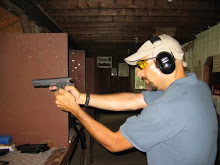
Old School
Yes, that is an actual, honest-to-goodness "BELL SYSTEMS PROPERTY" rotary phone from 1968 (in the comments to Tam's post, I had erroneously stated that I thought the phone was older). I retrieved this from my grandmother's house when she passed in 2002; it had been sitting in the garage for about 20 years. It replaced a much older rotary phone in the late '60s or early 70s, a concession to my grandfather's advancing age and hearing loss - there's an adjustable volume control in the handset.
1960s state of the art, baby!
One of these days I'm going to drive my nerd butt down to Radio Shack and get the adapters needed to convert this to a standard house jack. I don't know if it would be easier to find a converter and put one of the four-pronged plugs on the end (remember those? Weren't those the damnedest things ever?) and then get the adaptor to a standard plug.
And then I'm gonna call every single automated voice-mail hell-customer service number I can think of, because I've got a rotary phone, beeyotch!
Heh. That is all.







14 comments:
Jay,
I got a similar story. My grandfather retired from Western Electric in 1968 - where he built components used in rotary dial telephones. As a very young kid, I can recall having as a "toy" just the rotary dial mechanism, and recalling how heavy it was for such a small thing.
They don't build 'em like they used to.
- Brad
As a rotary phone owner, I have found lots of those "press 1" numbers just drop you off if you dont have a DTMF keypad.
Built like a brick privvy though!
Brad,
I'm absolutely kicking myself for not grabbing the IBM typewriter my grandparents had. It easily outweighed most Korean cars...
Wally,
You have a rotary phone and drive a Triumph.
Let me guess, your carry gun is a matchlock...
:)
Can you even dial with a rotary phone on current networks?
I'm not sure pulse dialing is still supported...
Triumph? No! But it - er -THEY - are Failures In Automotive Technology.
Debating putting my 3 teletypes on craigslist.... seriously.
Matchlock? Ludditeman not believe if newfangled fire. Hold still while I get me club :-)
A notable advantage of these phones, in a rural area, is they will work when the power is out. It's a good idea to have a dial, or a push button phone around. The old ones that don't need an outside power source, the phone line supplies the required power.
LOL- I know where there is a REAL Western Electric (AKA Southern Bell) Bakelite phone from the 40's that is still in use! Old family friend will NOT get rid of it, and it sits on her kitchen counter to this day!
Jay,
I learned to type on the IBM selectric. Yeah, built like 100 ton locomotive, and almost as heavy. I recall a decades-old popular mechanics article which detailed how to 'convert' the lowly typewriter into a computerized teletype machine. In my mind, that's a worthy project.
- Brad
Dude, my house used two rotary phones until the EIGHTIES. Around the mid-80s ('83 or '84) we got one of those push button phones that had no lights - they'll still work when the power goes out, btw - to replace the phone in my parents bedroom, but the 'main' phone was still a rotary until '85 or '86. Not joking.
Plus, I'm so old that we didn't even have to dial the area code OR the three digit prefix for local calls, so the rotary wasn't that big a deal since you were only dialing 4 numbers.
Bonus: it was just over 10 years ago that I threw away that first push-button replacement phone, which I took to college to use when we got phone lines in our dorm rooms ('88) and then used in our marriage as the 'last' phone (usually, in the kitchen or spare bedroom) as it died a quiet death in the late 90's after many uses.
RW,
Check the center of the rotary. That's my grandparents' phone number circa 1970.
We had to dial five digits because we shared an exchange with the large city (population ~ 50K) next to us. They had THREE exchanges, if you can believe it!
Obviously, that was long before cell phones and fax machines...
Sorry to tell you, but your wonderful find probably won't work nowadays, as pointed out by Wally. I've got a friend (one of few) that has an old phone like that, and it won't work any more. But if you REALLY want, there are rotary-to-DTMF converters available. IIRC, about $60 per.
It's still a classic. I remember my Grandma's high-tech "Candlestick" phone form the '60s. Rotary dial on the bottom, set it down to hang-up.
Jay, are you alluding to the famous Model M Keyboard?
Oh, a good old-fashioned phone that you can get mad with and slam it the hell up on someone. Kinda hard to do with the cell phones.
Find a new(er) phone and set it to rotary mode and see if it works on your line before you waste your time (and money) talking to someone at Radio Shack who has not a clue. And resist the urge to smack 'em with that old phone.
(I remember the good old days when the folks at Radio Shack knew something about electronics.)
Sigi, yes, they do work on a twisted-wire phone system. Probably not so much on a cable-phone setup (blech).
Reason I know is that I have a 1954 WE 500 in cherry red.
Jay, you probably won't find a 4-prong to modular adapter. But you can find a small terminal block.
Open up the 4-prong plug of the phone and unscrew the wires from the plug. There should be three: Red, green and yellow.
If you're lucky, RadShk might have a modular line cord that has U-connectors on the other end. If not, you have to do it the hard way: Take a modular line cord, cut off one end, and strip the cover back. There will be four wires inside: Red, green, yellow and black. Strip the ends of those (I know you know, but others may not).
Screw each of the wires from the modular cord to separate posts on the terminal block.
Screw the red wire of the phone to the same terminal as the red wire from the line cord.
Screw the yellow and green wires from the phone to the same terminal as the green wire from the line cord.
The yellow and black wires from the modular cord are not used.
That's how I wired mine in and it works.
Post a Comment